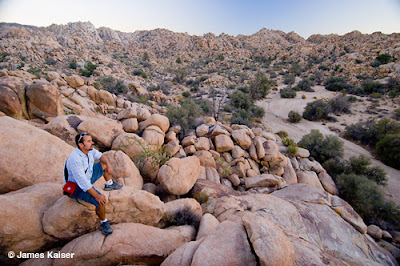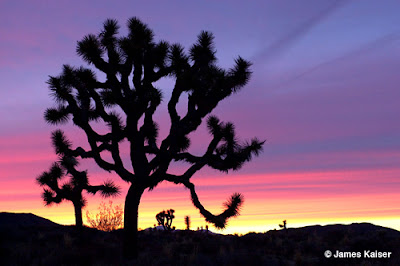I've recently been entranced with a guidebook series, written by James Kaiser (see our interview with this award-winning author and photographer here). James has penned four guides (thus far): Acadia: The Complete Guide; Joshua Tree: The Complete Guide; Grand Canyon: The Complete Guide (winner of the Benjamin Franklin Award for Best Full-Color Travel Guide and the Independent Publisher Award for Best Travel Guide); and Yosemite: The Complete Guide. We've interviewed James for each of the guides, so look for one each week for the next four weeks!
We'll start our author interview/book review with Joshua Tree: The Complete Guide. I've been intrigued with the area since I first heard U2's Joshua Tree album (yes, I am a child of the '80s). But Kaiser teaches us that Joshua Tree is so much more than a place - "Joshua Tree is beautiful. Joshua Tree is grotesque. Joshua Tree is peaceful, crazy, crowded, empty, freezing, sweltering, and a million other contraditions rolled into one." I have to say, I LOVE THIS BOOK.

Joshua Tree - Wonderland of Rocks
One of the hallmarks of a guidebook by James Kaiser is that you learn SO MUCH. From geography to history; adventures to wildlife - it truly is a complete guide. Did you know that Joshua Tree National Park has 800,000 acres, and only 2 main roads?
The guide lists the basics of Joshua Tree National Park - getting there, getting around, entrance fees, visitor centers, when to visit, weather, lodging, camping options, organized activities, and hazards. There are extremely useful maps of the campgrounds (with site numbers). Of particular interest to me, since my disabilities limit my camping options, are the gateway towns. Kaiser has described the local towns (full of characters, it seems) and gives plenty of options for restaurants, entertainment, outfitters, non-profits, and local festivals.
The Top Attractions in Joshua Tree include Hidden Valley (a hideout of cattle rustlers in the 1800s), Keys View, Ryan Mountain, 49 Palms Oasis, Arch Rock Natural Trail, Cholla Cactus Garden, and Lost Palms Oasis. You can find the complete details within this book. You'll also find a variety of hikes (with maps), laid out by nature trails & easy, moderate, and strenuous hikes. You'll learn rules for backpacking, climbing, and more. Did you know that there are over 200 miles of equestrian trails in Joshua Tree? You can take your own horses, or go on a guided trail ride.
In this book, we also learn about the geology of Joshua Tree (such incredible rocks), ecology, and native animals and plants (including the eponymous Joshua Tree). The history of the area is amazing, and has led to further reading on my part (love new topics to research - plenty here to discover).
The latter half of the book is packed with beautiful photos, maps, and descriptions of trails and the highlights of the park. Whether you're interested in grand scenery (Keys View, Skull Rock, Geology Tour Road) or smaller places (Gold Coin Mine, Cottonwood Spring), Joshua Tree National Park has something for everyone. As with reading all of Kaiser's books, now I SO WANT TO GO.
Please tell us about Joshua Tree Park...
Joshua Tree National Park is located in the Southern California desert, about an hour north of Palm Springs. The park is actually located on the boundary of the Mojave Desert and the Sonoran Desert, so there's an amazing mix of plants and animal from both ecosystems. Of course, the most famous plant is the Joshua Tree, which is one of the strangest-looking plants in the world.

Joshua Tree Sunset
Why is it an outdoor lover's paradise?
Because Joshua Tree is located in the desert, it's perfect for hiking and backpacking in the late fall or early spring. There are also thousands of bizarre rock formations, making Joshua Tree one of the world's premier rock climbing destinations.
Your first experience was not so good - what made you give it a second chance? (and fall in love with it?)
Ha! The first time I went to Joshua Tree was in January, and I got caught in a freak snowstorm. I had assumed the desert would be hot and dry, so I didn't pack any warm or waterproof clothes. I spent most of the trip cold, soggy, and shivering. Fortunately, I returned a few months later in the spring, and the temperature was perfect. Only then was I was finally able to enjoy the park. Of course, winter is still a great time to visit, but you need the right clothes!
Nature is such an integral part of Joshua Tree - what can visitors learn from the park system?
The desert is a weird and wonderful place, and it's home to some of the most interesting plants and animals in the world. The park service offers terrific ranger-led hikes that explore this ecosystem in-depth. Spend an hour with a ranger and you'll discover some of the amazing survival strategies plants and animals employ in the desert.
How can visitors best lessen their impact on the park?
Take only photos, leave only footprints.
How can we best teach our kids about Joshua Tree?
The great thing about Joshua Tree is that it appeals to kids on multiple levels. Some kids like watching lizards scamper around, while others enjoy spring wildflowers. And all kids are fascinated by rock climbers. Joshua Tree is really a fantastic place for kids to get excited about nature.
Thanks so much, James. We highly recommend Joshua Tree: The Complete Guide to our Wandering Educators!
For more information, please see:
All photos courtesy and copyright James Kaiser
